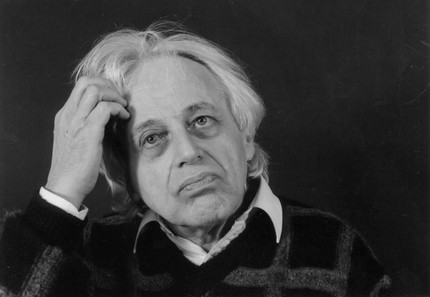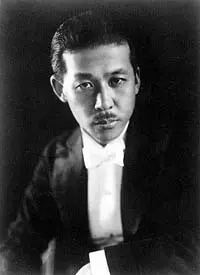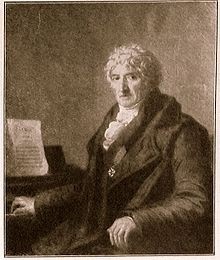
György Ligeti |
György Ligeti

The sound world of Ligeti, opened like a fan, the feeling of his music, barely expressible in words, the cosmic force, highlighting terrible tragedies for one or two moments, gives a deep and intense content to his works even when, at first glance, they are far from what or event. M. Pandey
D. Ligeti is one of the most prominent Western European composers of the second half of the XNUMXth century. Festivals and congresses, numerous studies around the world are dedicated to his work. Ligeti is the owner of many honorary titles and awards.
The composer studied at the Budapest High School of Music (1945-49). Since 1956 he has been living in the West, teaching in different countries, since 1973 he has been constantly working at the Hamburg School of Music. Ligeti began his career as a staunch Bartokian with a comprehensive knowledge of classical music. He constantly paid tribute to Bartok, and in 1977 he created a kind of musical portrait of the composer in the play “Monument” (Three pieces for two pianos).
In the 50s. Ligeti worked at the Cologne electronic studio – he later called his first experiments “finger gymnastics”, and relatively recently declared: “I will never work with a computer.” Ligeti was the first authoritative critic of certain types of compositional technique, common in the 50s. in the West (serialism, aleatorics), devoted research to the music of A. Webern, P. Boulez and others. By the beginning of the 60s. Ligeti chose an independent path, proclaiming a return to open musical expression, asserting the value of sound and color. In the “non-impressionistic” orchestral compositions “Visions” (1958-59), “Atmospheres” (1961), which brought him worldwide fame, Ligeti discovered timbre-colorful, spatial orchestral solutions based on an original understanding of polyphonic technique, which the composer called “micropolyphony”. The genetic roots of Ligeti’s concept are in the music of C. Debussy and R. Wagner, B. Bartok and A. Schoenberg. The composer described micropolyphony as follows: “polyphony composed and fixed in the score, which should not be heard, we hear not polyphony, but what it generates … I will give an example: only a very small part of an iceberg is visible, most of it is hidden under water. But how this iceberg looks like, how it moves, how it is washed by various currents in the ocean – all this applies not only to its visible, but also to its invisible part. That is why I say: my compositions and the way of recording are uneconomical, they are wasteful. I indicate many details that are not audible by themselves. But the very fact that these details are indicated is essential to the overall impression … “
I now thought of a huge building, where many details are invisible. However, they play a role in general, in creating the overall impression. Ligeti’s static compositions are based on changes in the density of sound matter, mutual transitions of colorful volumes, planes, spots and masses, on fluctuations between sound and noise effects: according to the composer, “the original ideas were about widely branched labyrinths filled with sounds and gentle noises.” Gradual and sudden influxes, spatial transformations become the main factor in the organization of the musical (time – saturation or lightness, density or sparseness, immobility or speed of its flow are directly dependent on changes in the “musical labyrinths”. Other compositions of Ligeti of the 60s are also associated with sound-colorfulness years: separate parts of his Requiem (1963-65), the orchestral work “Lontano” (1967), which refracts some ideas of “romanticism today.” They reveal the increased associativity, bordering on synesthesia, inherent in the master.
The next stage in Ligeti’s work marked a gradual transition to dynamics. The streak of searching is connected with the completely restless music in Adventures and New Adventures (1962-65) – compositions for soloists and instrumental ensemble. These experiences in the absurd theater paved the way for major traditional genres. The most important achievement of this period was the Requiem, combining the ideas of static and dynamic composition and dramaturgy.
In the second half of the 60s. Ligeti begins to work with “more subtle and fragile polyphony”, gravitating towards greater simplicity and intimacy of utterance. This period includes Branches for string orchestra or 12 soloists (1968-69), Melodies for orchestra (1971), Chamber Concerto (1969-70), Double Concerto for flute, oboe and orchestra (1972). At this time, the composer was fascinated by the music of C. Ives, under the impression of which the orchestral work “San Francisco Polyphony” (1973-74) was written. Ligeti thinks a lot and willingly speaks out on the problems of polystylistics and musical collage. The collage technique turns out to be quite alien to him – Ligeti himself prefers “reflections, not quotations, allusions, not quotations.” The result of this search is the opera The Great Dead Man (1978), successfully staged in Stockholm, Hamburg, Bologna, Paris, and London.
Works of the 80s discover different directions: Trio for violin, horn and piano (1982) – a kind of dedication to I. Brahms, indirectly connected with the romantic theme Three fantasies on verses by F. Hölderlin for a sixteen-voice mixed choir a cappella (1982), loyalty to the traditions of Hungarian music is upheld by the “Hungarian etudes” to the verses by Ch. Veresh for a mixed sixteen-voice choir a cappella (1982).
A new look at pianism is demonstrated by piano etudes (First Notebook – 1985, etudes No. 7 and No. 8 – 1988), refracting different ideas – from impressionistic pianism to African music, and the Piano Concerto (1985-88).
Ligeti’s creative imagination is nourished by music from many eras and traditions. The inevitable associations, the convergence of distant ideas and ideas are the basis of his compositions, combining illusory and sensual concreteness.
M. Lobanova





